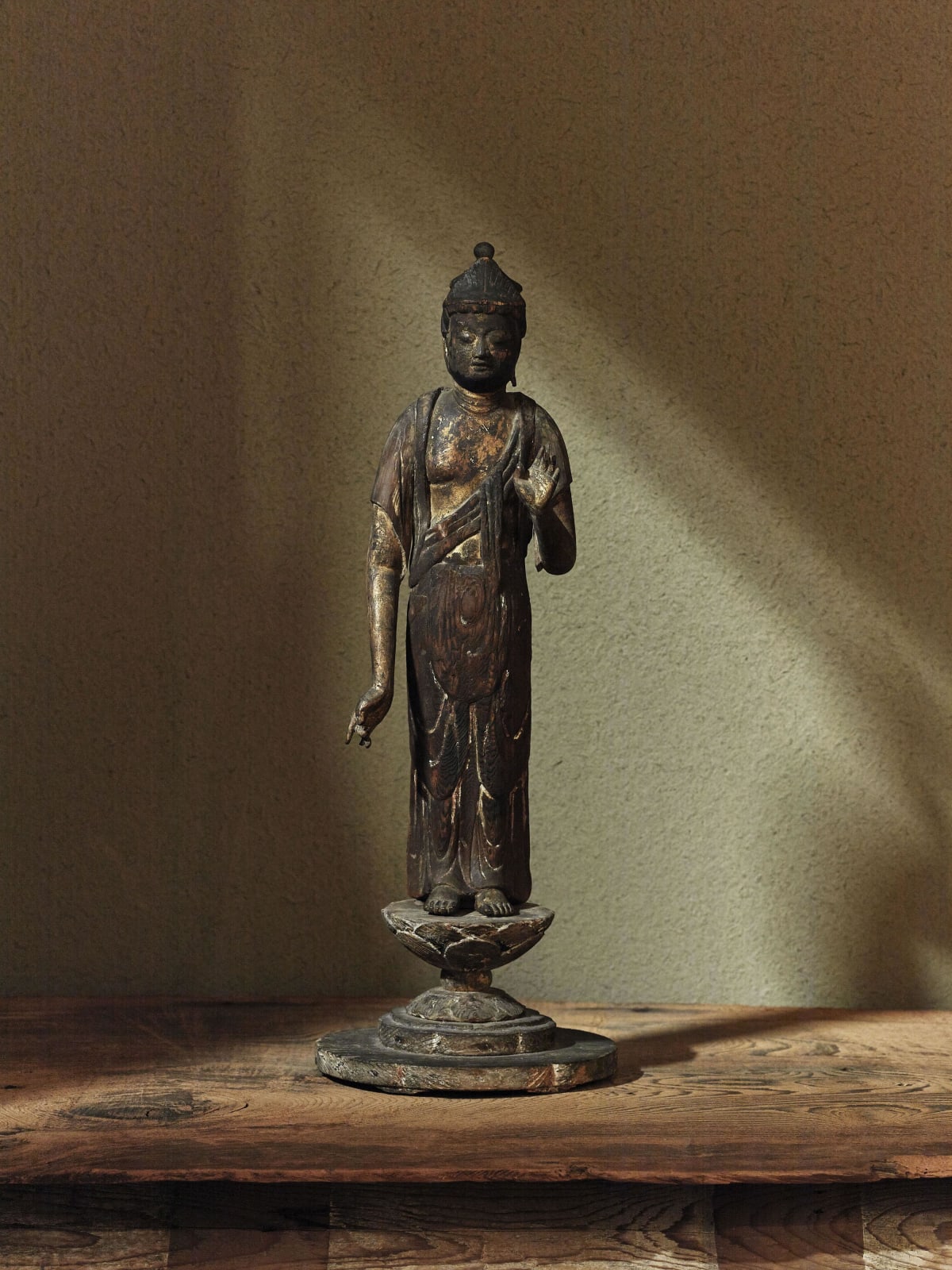Standing Kannon
Wood
Late Heian period (12th c.)
W17 x H48 cm
Late Heian period (12th c.)
W17 x H48 cm
Further images
The Kannon stands with his right arm relaxed on his side and the left arm bent at the elbow, an open palm raised in gesture towards the viewer. His upper body is slightly shifted to the left side, creating a delicate and graceful impression. With its small height of 37.5 cm excluding the dais, the statue corresponds to the type of the Thousand Buddhas of Kofukuji temple, small representations of the standing bodhisattva Sho-Kannon.
The production of sets of the Thousand Buddhas was part of a larger movement in the late Heian period of producing Buddhist paintings and statuary in order to accumulate spiritual merit. Kofukuji temple was the family temple of the powerful Fujiwara clan, and the temple’s prosperity was linked to the generous donations it received from aristocrats and courtiers who orbited these political hegemons. However, little is known about the patrons and their motivations of the Thousand Buddhas. Even a cursory look on the extant examples reveals quite a range of styles and different levels of skill displayed by the craftsmen, suggesting that the Thousand Buddhas continued to be produced over a considerable time and by numerous different makers. Because of their fragility, arms, hands and toes are often missing, and often these parts and the dais are replacements of a later time. The Standing Kannon’s arms, toes and dais are made from a different wood than the main parts of the body. On parts of the object’s surface, traces of lacquered gold leaf are discernible, and the recessed areas of the drapery evince remainders of white and reddish polychrome, hinting on the object’s original, more colorful guise.
Standing tall despite the small overall size, the examples of the Thousand Buddhas of Kofukuji temple embody the waning splendor of the late Fujiwara era. With their modest yet refined appearance, they have been a favorite among persons of taste who would often treasure them from generation to generation. One anecdote, for instance, concerns the celebrated collector Masuda Don’o (Masuda Takashi, 1848–1938). Briefly after the Russo-Japanese War (1904–05), Kofukuji temple attempted to raise money to reconstruct some of its buildings and decided to sell off damaged Buddhist sculptures and other items from among the temple treasures. Masuda acquired the whole offering at once. When he died, fifty examples of the Thousand Buddha type from his estate were promptly acquired by Fujita Denzaburo, like Masuda a fellow industrial pioneer of the Meiji period and avid art collector. This Standing Kannon comes without such lofty pedigree, but nevertheless it forms part of a legacy of the ancient artistic traditions of Kofukuji temple which for centuries have been cherished by Japanese connoisseurs.
The production of sets of the Thousand Buddhas was part of a larger movement in the late Heian period of producing Buddhist paintings and statuary in order to accumulate spiritual merit. Kofukuji temple was the family temple of the powerful Fujiwara clan, and the temple’s prosperity was linked to the generous donations it received from aristocrats and courtiers who orbited these political hegemons. However, little is known about the patrons and their motivations of the Thousand Buddhas. Even a cursory look on the extant examples reveals quite a range of styles and different levels of skill displayed by the craftsmen, suggesting that the Thousand Buddhas continued to be produced over a considerable time and by numerous different makers. Because of their fragility, arms, hands and toes are often missing, and often these parts and the dais are replacements of a later time. The Standing Kannon’s arms, toes and dais are made from a different wood than the main parts of the body. On parts of the object’s surface, traces of lacquered gold leaf are discernible, and the recessed areas of the drapery evince remainders of white and reddish polychrome, hinting on the object’s original, more colorful guise.
Standing tall despite the small overall size, the examples of the Thousand Buddhas of Kofukuji temple embody the waning splendor of the late Fujiwara era. With their modest yet refined appearance, they have been a favorite among persons of taste who would often treasure them from generation to generation. One anecdote, for instance, concerns the celebrated collector Masuda Don’o (Masuda Takashi, 1848–1938). Briefly after the Russo-Japanese War (1904–05), Kofukuji temple attempted to raise money to reconstruct some of its buildings and decided to sell off damaged Buddhist sculptures and other items from among the temple treasures. Masuda acquired the whole offering at once. When he died, fifty examples of the Thousand Buddha type from his estate were promptly acquired by Fujita Denzaburo, like Masuda a fellow industrial pioneer of the Meiji period and avid art collector. This Standing Kannon comes without such lofty pedigree, but nevertheless it forms part of a legacy of the ancient artistic traditions of Kofukuji temple which for centuries have been cherished by Japanese connoisseurs.





